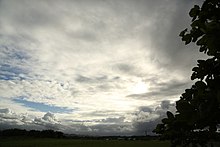Climate of Puerto Rico
Easterly trade winds pass across the island year round while the rainy season stretches from April into November.
About a quarter of the average annual rainfall for Puerto Rico occurs during tropical cyclones, which are more frequent during La Niña years.
For example, when Hurricane Maria made landfall on the island in 2017 at Category 5 strength, 100% of the power grid was lost.
[28] The hurricane completely destroyed the island's power grid, leaving all 3.4 million residents without electricity.
[29] Hurricane Maria caused a humanitarian crisis in Puerto Rico, with damages estimated in 90 billion dollars and a loss of human life close to three thousand.
Weather conditions can be very rainy as tropical lows pass near the island, with frequent strong thunderstorms.
By early November the tropical cyclone season fades and the weather becomes drier and generally sunny.
Weakening cool fronts from the north lower temperatures and humidity, and dry and sunny conditions prevail.
In the central area of the island the elevation and reduced sea effects bring the minimum temperatures to 55–65 °F (13–18 °C) on average.




